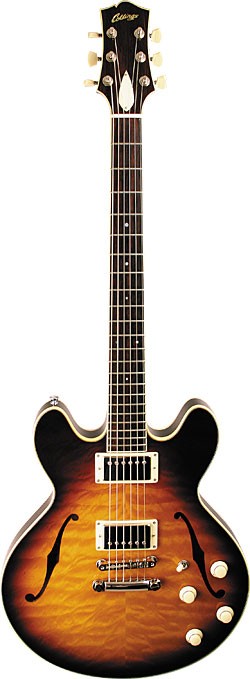
2006 Collings I-35.
Occasionally, in the world of guitars, events influence the market. The introduction of a new guitar can send ripples through the industry. Not so long ago, Paul Reed Smith redefined quality workmanship and set a new standard.
Bill Collings has been building highly regarded acoustic guitars for decades. He created an organization that produces boutique-quality instruments in a factory setting, and he recently charged this organization with creating electric guitars on the same level, both functionally and aesthetically. The result is the I-35.
Named for Austin’s infamous traffic artery, the I-35 is aesthetically reminiscent of a Gibson ES-335. But it’s by no means a thinly veiled copy. The body is pared down slightly at 15″ wide, and it has a slightly more angular shape that comparatively reduces its size and weight. In terms of appointments, the guitar is pure Collings, with ivoroid all around and perfection in its detail.
Construction of the I-35’s body is quite different from the standard semi-hollow electric. In contrast to the traditional method of using pressed plywood and bent sides, Collings carves the back and sides from a single slab of mahogany. A solid top is then carved from bookmatched maple. The body is heavily chambered to duplicate the density of the traditional style. This technique is cleverly used to yield a sonic advantage, but preserves the aesthetic under the f-holes. The neck joint illustrates the attention to detail and proper execution of superior design. The back actually extends over the heel (like a violin), eliminating the ledge typically seen between the top of the back and the back of the heel. To execute this look, the heel is actually bound in matching ivoroid and carved to match. The result is a no-compromise neck joint, functionally and aesthetically.
Mahogany used to build the body and neck is superior quality, as is the maple top. The headstock and fingerboard are unbelievable cool Brazilian Rosewood, an upgrade bordering on extinction in most circles. Every visible plastic part is from the same batch of traditional ivoroid-colored nitrate plastic. The truss-rod cover, pickup mounting rings, and knobs are all manufactured in-house to ensure that is the case. Even the handles of the Sperzel tuners are ivoroid!
Hardware continues the theme; pickups are a custom set built by Jason Lollar and are among the best PAF-style. They’re faithful copies with a full, medium-output sound that exhibits the true texture and requency response of a good PAF. The pickups are not bright, and their treble response can be tailored by adjusting the pickup’s saturation. As they’re pushed, they react with a smooth compression without becoming excessively bright. And they allow for a smooth, darker tone when distanced from the string, but when adjusted closer have just enough aggression to cut through.
The bridge and tailpiece are a nickel-plated TonePros locking tailpiece and ABR-1-style set. This is a solid setup that tightens the guitar’s attack. Because the saddle adjustment screws are held firmly in place by snap rings, the characteristic tendency to crackle is eliminated, and notes have a cleaner attack. A properly cut bone nut, in conjunction with properly leveled and polished frets, complete the system.
Physically, this guitar has no weaknesses. It sounds great unplugged (as all guitars should). The feel is very comfortable with a medium C-shaped neck and a 111/16″ nut width. The edges of the fingerboard are slightly rounded, giving it a broken-in feel, and the setup was well-done from the factory and is easily adjustable after unlocking the set screws that secure the bridge.



